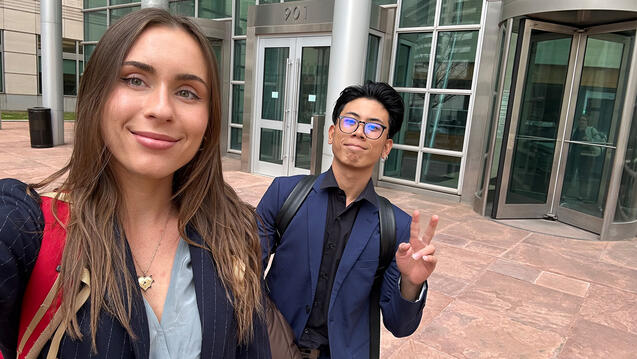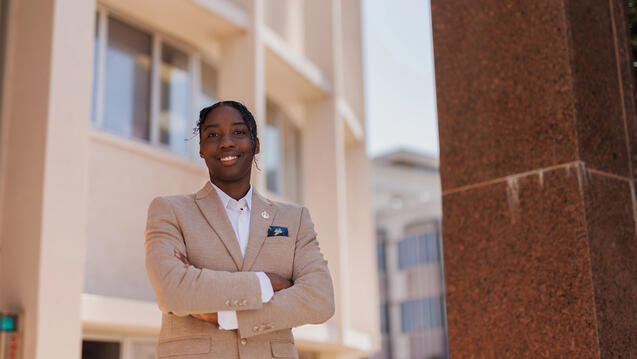The Inheritance of Integrity

As a child, Mary Jane Theis ’74 would feel a thrill whenever she ascended the steps of the Illinois State Capitol.
Taller than the United States Capitol in Washington, D.C., the domed building in Springfield was at once familiar and awe-inspiring: It was her dad’s workplace, but it was also a place where she sensed that history was happening. Her father, Representative Ken Wendt, was a member of the Illinois General Assembly from 1952 to 1962, and she recalls, “The big issue then was civil rights, and even as a child I remember learning that it was a place where the law could right wrongs.”
She didn’t imagine that decades later, on Nov. 14, 2022, she would be sworn in as chief justice of the Illinois Supreme Court less than half a mile away.
Though she may not have envisioned herself as head of the entire judicial system of the state of Illinois, she did know from a young age that she would be involved with the judiciary in some capacity. By the time Representative Wendt was appointed to the Cook County bench when she was in high school, his daughter’s fascination with visiting his workplace had sharpened into something more tangible: a goal. “Seeing my father preside over his courtroom, I watched the law in action. And I knew what my life’s purpose would be.”
Chief Justice Theis was born and raised in Chicago, as was her father before her, and that’s far from the only similarity in their lives’ paths. Both attended Jesuit universities (he at Marquette, she at Loyola University Chicago), both went on to law school (he at John Marshall Law at the University of Chicago, she at USF), and both deeply felt a call to service. “The same values animated our lives,” Chief Justice Theis says. “Those were Jesuit values.”
Those values were also what brought her to USF Law. Having followed “a cute boy with curly red hair” (that would be John Theis ’73, her husband of 50-plus years) to California, Chief Justice Theis deemed USF “Loyola by the Bay” and immediately felt at home on the Hilltop. “The intellectual rigor, the call to serve…all these things felt so familiar to me.” What was a surprise, though, was how law school worked.
“I expected to memorize cases and learn facts. But what I realized is that law school would teach me how to think.” She remembers the moment the law clicked for her: sitting in Corporations, a class in which the subject wasn’t interesting on its own, but benefited by being taught by Prof. James Cox. “He made the subject come alive, and all of a sudden I could see the law as an organic whole, comprised of all these very important ideas that fit together, these principles that are applicable across the board.” She connects that moment with her work today: As a review justice, she has to be a generalist. Knowing how to read a case, how to think about a precedent, how to apply the written law to the flesh-and-blood people who are the ones ultimately affected by a ruling. All these abilities came as the result of an “aha” moment on Fulton Street. They’re abilities that have served her well. “I trust her implicitly,” said former colleague and friend of 40 years, retired Illinois Supreme Court Justice Rita Garman. “Chief Justice Theis is always well-prepared, insightful, deliberate…if I ever read an opinion of hers that I didn’t agree with, I would go back and reread the entire case to see if there was something I missed.”
But Chief Justice Theis’ legal mind wasn’t forged in an ivory tower. Her dedication to the scholarly aspect of the law was balanced by work in the trenches—even before she graduated. During her first two years at USF Law, the Bay Area legal community had been left reeling after infamous incidents known as the San Quentin Six and the Marin County Massacre, during which multiple people were killed or seriously injured, including a judge, a district attorney, and several prison guards. At the onset of the resulting criminal trial, the Marin County Public Defender’s Office reached out to USF asking for accomplished 3Ls to help ease their load. Chief Justice Theis answered the call. “So I was practicing law from the time I was a 3L,” she says. “And what I remember from that time was that when the local legal community was suffering, USF stood up.”
She took the skills she honed in that Marin County office when she moved back to her beloved Chicago and practiced as an assistant public defender in Cook County. “As a public defender, I was in court every day, practicing every day. I came to appreciate the intimacy of the law— representing someone who is so dependent upon you is powerful.” When she began a judicial career that’s now in its fifth decade—serving as an associate judge, a circuit court judge, an appellate court judge, and then as a justice of the Illinois Supreme Court, Chief Justice Theis made sure to remember that the law is, at its most fundamental, created by and for people.
“Judges are given the opportunity to change people’s lives in dramatic ways, but only in relation to how much the public trusts the judiciary,” she says. She goes on to assert that the judiciary has an obligation to heal what she calls “the gap of trust” wherever it exists, through innovation of the system or community outreach. It’s a big part of the role she plays now. As the chief justice, she presides over every court in Illinois, which means making policy and setting precedent. The way she rules hearkens back to how she saw her father preside, especially when he served as a judge in the Narcotics Division of the Criminal Courts.
“I’d go to his courtroom and see the actual impact of what he was doing—he was an early adopter of rehabilitation, not incarceration, for drug addicts, because he saw them as people,” she says. It’s no surprise, then, that the cases that most frustrate her as Illinois’ top jurist are ones in which “the lawyers just talk to each other and forget to include the court. We’re the ones making the decisions that affect the people in the case.” Conversely, her most rewarding cases are those that have an unsettled area of the law to decide: That’s where there’s work to be done, and where she can be of the most service.
Although Chief Justice Theis acknowledges that it’s hard to build a system that works for everyone, looking for solutions to problems both legal and administrative is her favorite part of the job.
It’s one she has no plans to leave anytime soon. “There’s too much to think about—I’m not retiring!” Her old friend Justice Garman has one lament about her own retirement: “That I didn’t get to serve with Mary Jane on the bench as chief justice.”
When she’s not busy helming the giant ship that is the Illinois justice system, Chief Justice Theis is adhering to the same values she always has. Family comes first, and though John Theis’ curly red hair is now white, they remain one another’s biggest cheerleader. Their two children live just miles from them in Chicago with their own kids, and when asked to answer a Proust questionnaire’s query about her “perfect happiness,” she references a recent family trip. “We took our children and all of our grandchildren to Tuscany, we ranged from 75 years to 4 years old, we ate gelato, and the kids jumped in the pool, and when I think of golden moments, I cannot think of anything that would bring me more joy than that week in Italy.”
But after that perfect moment of hers? Shortly after returning to the United States, Chief Justice Theis was in her chambers, back to work, being of service.


